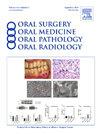The effect of a blooming artifact reduction filter on the dimensional analysis of implants
IF 2
3区 医学
Q2 DENTISTRY, ORAL SURGERY & MEDICINE
Oral Surgery Oral Medicine Oral Pathology Oral Radiology
Pub Date : 2024-08-09
DOI:10.1016/j.oooo.2024.08.004
引用次数: 0
Abstract
Objective
To assess the effect of a blooming artifact reduction (BAR) filter on cone beam computed tomography (CBCT) images in the dimensional analysis of dental implants.
Study Design
Six types of implants (n = 5 for each type) composed of titanium (3 types), titanium-zirconia alloy, zirconium oxide, and titanium-aluminum-vanadium alloy, and made with 2 manufacturing processes (milled and printed) were individually installed in a bovine rib block according to the manufacturer's protocol. CBCT images were acquired with i-CAT and Carestream scanners, randomized, and analyzed without and with the e-Vol DX BAR filter (60 images for each scanner). Implant length, diameter, and thread-to-thread distance were measured by two radiologists, with a stereomicroscopic image of each implant as the reference standard for calculation of distortion in measurements. Repeated measures ANOVA with Bonferroni corrections and intraclass correlation coefficients (ICC) were applied (α = 0.05).
Results
The BAR filter significantly reduced distortion in various parameters for specific implants, aligning closely with stereomicroscopic measurements. Titanium and printed implants showed reduced dimensional distortion regardless of BAR filter use. Carestream measurements presented smaller dimensional differences than i-CAT for most implants and parameters, especially without BAR (P < .05). Interexaminer reliability was good to excellent, with ICC ranging from 0.80 to 0.95.
Conclusions
The BAR filter can enhance implant dimensional analysis, although variations based on implant material and manufacturing process were observed.
减少模糊伪影过滤器对植入物尺寸分析的影响
目的:评估锥形束计算机断层扫描图像(CBCT)在牙科植入物的尺寸分析中使用花斑伪影减少(BAR)滤波器的效果。按照生产商的规程,将六种类型的种植体(每种类型 5 个)分别安装在牛肋骨块上,这些种植体由钛(3 种)、钛-氧化锆合金、氧化锆和钛-铝-钒合金组成,采用两种生产工艺(铣削和印刷)制造。使用 i-CAT 和 Carestream 9600 扫描仪采集 CBCT 图像,对图像进行随机化处理,并在不使用和使用 e-Vol DX BAR 过滤器的情况下对图像进行分析(每台扫描仪各采集 60 幅图像)。由两名放射科医生测量种植体的长度、直径和螺纹间距,并以每个种植体的立体显微镜图像作为计算测量失真的参考标准。采用重复测量方差分析,并进行 Bonferroni 校正和类内相关系数 (ICC) 计算(α = 0.05)。BAR 过滤器明显减少了特定种植体各种参数的失真,与体视显微镜测量结果非常吻合。无论是否使用 BAR 过滤器,钛和印刷种植体的尺寸变形都有所减少。对于大多数种植体和参数,Carestream 测量的尺寸差异比 i-CAT 测量的尺寸差异要小,尤其是在不使用 BAR 的情况下 ( < .05)。检查者之间的可靠性从良好到极佳,ICC 在 0.80 到 0.95 之间。BAR 过滤器可以提高种植体的尺寸分析能力,但根据种植体材料和生产工艺的不同也会出现差异。
本文章由计算机程序翻译,如有差异,请以英文原文为准。
求助全文
约1分钟内获得全文
求助全文
来源期刊

Oral Surgery Oral Medicine Oral Pathology Oral Radiology
DENTISTRY, ORAL SURGERY & MEDICINE-
CiteScore
3.80
自引率
6.90%
发文量
1217
审稿时长
2-4 weeks
期刊介绍:
Oral Surgery, Oral Medicine, Oral Pathology and Oral Radiology is required reading for anyone in the fields of oral surgery, oral medicine, oral pathology, oral radiology or advanced general practice dentistry. It is the only major dental journal that provides a practical and complete overview of the medical and surgical techniques of dental practice in four areas. Topics covered include such current issues as dental implants, treatment of HIV-infected patients, and evaluation and treatment of TMJ disorders. The official publication for nine societies, the Journal is recommended for initial purchase in the Brandon Hill study, Selected List of Books and Journals for the Small Medical Library.
 求助内容:
求助内容: 应助结果提醒方式:
应助结果提醒方式:


